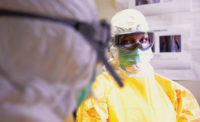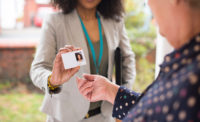As of late September, more than 200,000 Americans have died from COVID-19, and experts from the University of Washington’s Institute for Health Metrics and Evaluation (IHME) predict another 180,000 American deaths before the end of the year. Worldwide, the figures are equally startling: 966,970 have died as of this writing. The IHME stated in mid-September that “Increasing mask use to 95% can save nearly 115,000 lives before the end of 2020, reducing the expected number of deaths by 62.5%.”
It’s a matter of life and death for some, and debilitating illness for many others affected by the virus. With a vaccine still under development, people must take basic measures to prevent the spread of the virus. Mask wearing, physical distancing, and contact tracing have become the “new normal” in workplace and public settings, and a matter of state law in many cases. The mandates impact almost all organizations in private and public sectors, from college campuses to casinos, airport terminals, retail stores, shopping malls, and warehouses. Businesses and municipalities must find efficient ways to adopt, implement and comply with current public health mandates.
For risk managers, the costs of not implementing public health mandates can be multi-fold. Increased illness among employees may lead to loss of employee productivity and low morale. Failure to abide by building occupancy laws may lead to local government fines. And, if the general public perceives a business or workplace as unhealthy, that can lead to loss of customer revenue, and a tarnished reputation. The economic fallout that has accompanied the pandemic makes it critically important to abide by COVID safety measures, for the sake of business resilience and risk management.
Key lesson learned: improve situational awareness
When the pandemic hit suddenly in March 2020, organizations had little or no time to research solutions and best practices. They had no choice but to quickly roll out new business practices and technologies to reduce the risk of infection among visitors, customers, and employees. Now several months later, organizations have acquired some tools and have a better understanding of best practices, but they still face a plethora of choices and decisions about the most effective ways to reduce COVID transmission, drive contact tracing efforts, and comply with local, state, and federal public health mandates. One thing has become clear; to abide by the “new normal” restrictions, organizations need to be constantly aware of their environments’ compliance, in real-time. To do that, they need to improve their situational awareness, so they can quickly assess evolving situations and respond when violations occur.
Encouraging compliance impacts security, operations, and human resources
Although everyone in an organization should help ensure that rules are followed and safety standards are met, the burden of compliance primarily falls on operations, security and human resource professionals. Adding those responsibilities to a anyone’s job description is overwhelming, because constantly monitoring every person and every area of a building or public space is virtually impossible; there simply aren’t enough staff resources to do that.
Leveraging video surveillance with video content analytics
Fortunately, many organizations already have one technology system that can help: video surveillance (CCTV) networks. Organizations can leverage these existing investments and complement those cameras with video analytics software to harness video footage data, in real-time. Video intelligence technology is powered by Artificial Intelligence (AI) and detects, identifies and classifies the objects in video content to allow organizations to quickly review footage from past incidents; increase situational awareness and response time to evolving situations; and obtain trend data for developing strategies. The technology serves many purposes for various business groups across a broad array of industries, such as law enforcement, retail, healthcare, higher education, and urban planning. Since the onset of the COVID pandemic, many organizations are turning to video content analysis because it is a powerful tool to monitor compliance with public health standards relating to face masking, physical distancing, building occupancy and sanitation.
Real-time alerting for real-time response
Video intelligence software enables operators to proactively respond to situations, via real-time alerts, to address a variety of problems. It enables organizations to leverage video data to establish benchmark norms for behavior, and then create rule-based alerting logic to detect anomalous behavior. This is useful in certain environments where masks are mandated; in a grocery store, for example, alerts can be configured to notify managers when someone is not wearing a mask. Similarly, alerts can be triggered at the store checkout queues or at a distribution fulfillment center when individuals are not maintaining physical distance of at least six feet. In these scenarios, alerts help managers respond quickly to enforce the business or workplace safety rules.
While it is virtually impossible for a human eye to accurately assess whether customers in a department store or an airport are abiding by social distancing rules, video content analysis can do so, across multiple cameras, using proximity identification technology that can measure, quantify and analyze the distances between individuals. With real-time alerting, managers can assess and respond to a situation and, if necessary, deploy staff or create signage to ensure customers, visitors, or employees are maintaining a safe distance of at least six feet apart from others.
Managing occupancy and sanitation
There have always been fire and building code occupancy limits for buildings, whether they are restaurants, theaters, workplaces, or municipal buildings. However, under COVID conditions the rules have become stricter, to facilitate physical distancing. Even some outdoor events have attendee restrictions. Crowding is the antithesis of distancing, so it is vitally important to be able to detect crowding in buildings. To ensure compliance with occupancy rules, organizations can use video content analysis-driven people-counting alerts, configured to notify managers whenever the number of people in a building (or area of a building) exceeds a pre-determined threshold. From a visitor experience standpoint, such functionality also helps organizations proactively detect pedestrian traffic bottlenecks, so they can send staff to redirect foot traffic to other pathways or access points. Furthermore, people counting also helps maintenance managers get accurate, real-time data regarding the number of people who have used a particular area of a building, such as a food court or restroom, so they can more efficiently and effectively deploy staff to clean and sanitize those areas based on actual usage rather than rigid schedules.
Efficient contact tracing
Preventing transmission is critically important, but employers also need tools to help them when an employee has become infected, so they can investigate whether any other customers, colleagues, or visitors may have been infected by sustained contact with that employee. Contact tracing is a way for organizations to determine which of their employees or visitors may have been in contact with someone who is infected with COVID-19. With video content analytics, organizations can facilitate employee contact tracing by using a combination of facial recognition and proximity identification filters. Those analytics can pinpoint whether an infected employee spent at least 15 minutes with another person, at less than six feet apart, during the infectious stage. The organization can protect the anonymity of the infected individual, but still notify anyone who was exposed, so they can self-quarantine.
Harnessing data trends for compliance
To assess how effectively they are managing compliance with COVID public health mandate, businesses also need to know how they are performing in terms of healthy safety. They must gather trend data that indicates where and when safety and compliance issues most often arise. Video content analytics software is extremely beneficial in this regard because it can aggregate data over time and present it in visual dashboards and reports. Operators can therefore get anonymous yet quantifiable data to easily determine whether staff, visitors, and customers are complying with physical distancing and mask mandates. Based on that business intelligence, managers can make informed decisions and strategies to improve their health safety education and enforcement. Having visibility into patterns of behavior also helps system operators determine which type of real-time alerts would be most useful to an organization. Managers can also use this functionality to document compliance, to prove that they are taking steps to ensure the safety of their employees, visitors, and customers.
Organizations must be constantly aware of what’s happening in their environments to ensure compliance with COVID safety measures and demonstrate that they are operating safely for all stakeholders (customers, employees and visitors). This requires constant vigilance and due diligence. Organizations need to monitor compliance in real-time by managing specific instances, but they also need anonymous reporting of compliance trend data. Among the various technology solutions that attempt to address these challenges, video content analytics is the most cost-effective approach because it helps organizations get more value from common video surveillance systems by harnessing valuable data that otherwise lies hidden and untapped in video footage.




